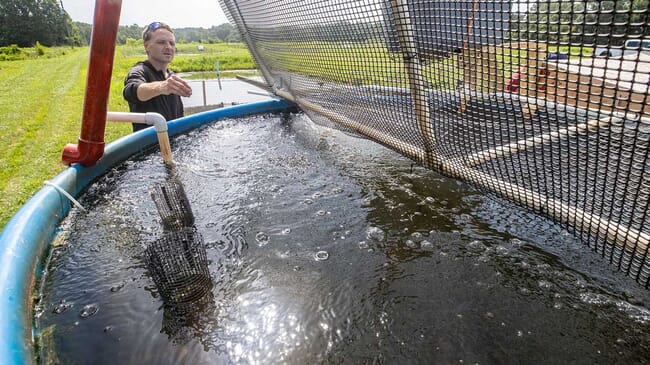
Researchers at Southern Illinois University Carbondale (SIU) are embarking on a study aimed at enhancing the farming techniques for largemouth bass, a species known for its predatory behaviour, including cannibalism. With a grant of $324,000 from the U.S. Department of Agriculture, the two-year project seeks to improve intensive aquaculture methods to increase the productivity and predictability of largemouth bass farming.
The research is a collaborative effort involving SIU, Purdue University, and Big House Fish Farm, a local industry partner. The study is expected to conclude in autumn 2024.
A growing market
Traditionally farmed for recreational fishing, largemouth bass is now becoming an increasingly valuable food fish, generating approximately $3 million annually for fish farmers in Southern Illinois, with potential for further growth.
“Largemouth bass are apex predators and are not naturally inclined to thrive in high-density environments,” explained Jim Garvey, director of the Centre for Fisheries, Aquaculture, and Aquatic Sciences at SIU. “In their natural habitat, these fish consume live prey, often including their own kind. It’s common for a pond full of small bass to end up with only a few large survivors that have cannibalised their siblings.”
The study focuses on identifying ways to reduce cannibalism among largemouth bass while promoting the consumption of formulated feeds.
Research in action
The SIU research team, led by Garvey and assistant professor of environmental engineering Habibollah Fakhraei, includes researchers Hannah Holmquist, Asyeh Sohrabifar, post-doctoral student Giovanni Molinari, and doctoral student Alexander “Koaw” Zaczek. The project is being conducted in nine ponds located near SIU’s Touch of Nature Environmental Education Centre.
The team is monitoring how different holding methods affect the survival and growth of approximately 11,000 bass. They are particularly interested in the nitrogen cycles within each enclosure, which play a crucial role in processing the waste generated by the fish. Daily and weekly samples are collected to assess nutrient levels and other environmental factors.
“We’re investigating whether the ammonia produced by the fish waste is more effectively processed in the split-ponds, which could be more conducive to fish health compared to control ponds,” said Zaczek.
Tackling cannibalism
A key challenge in the study is encouraging more uniform feeding among the bass to reduce the likelihood of cannibalism. Zaczek noted that in larger ponds, it can be difficult to ensure all fish take to the feed early, which often results in some fish growing larger and preying on their smaller counterparts.
“The hope is that by confining the fish in smaller spaces with higher densities, they will be more likely to feed consistently and grow at similar rates,” Zaczek explained. “If the fish are of similar size, they are less likely to turn on each other.”
Implications for the industry
Should the tank-side or split-pond methods prove more effective, they could lead to increased survival rates and more consistent fish sizes, thereby enhancing marketability.
This research could also inspire other fish farmers to adopt these methods for different species, such as catfish, potentially broadening the impact of the study across the aquaculture industry.
“Buyers prefer fish of uniform size, and producers benefit from being able to supply more consistent products,” said Zaczek. “As with any industry, efficiency is key in aquaculture.”




